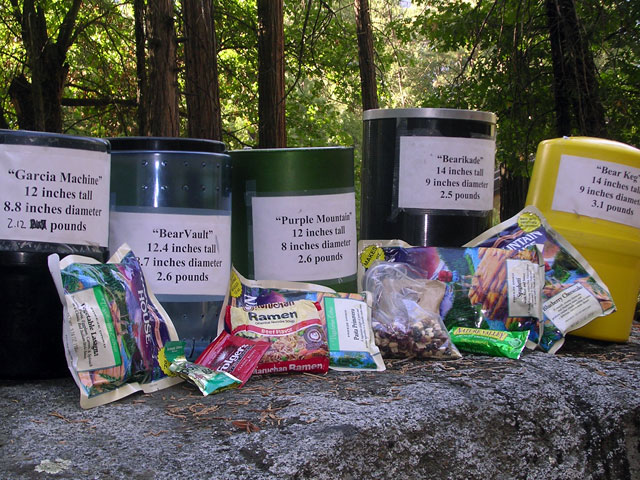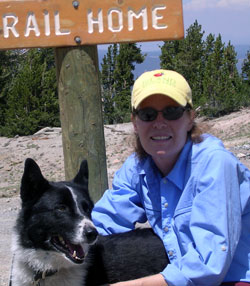
In 2004, when Yosemite National Park began requiring backpackers in certain areas to use bear-resistant food canisters, McCurdy was confronted with the question of whether the canisters were actually effective. She came to work with Steve Martin at Humboldt State to try and find the answer. Recently, the findings of her thesis research were published in the peer-reviewed journal, International Journal of Wilderness.
“Kate was a bear biologist for the National Park Service in Yosemite. So she was very aware of the problem of bears getting into people’s food,” Martin says. “She wanted to do something more about it.”
It is important for backpackers to have properly stored food because, among other things, animals associate humans with food. In addition to potentially dangerous encounters with wildlife, campers can also attract animals like corvids– such as jays and ravens – into areas that are not their natural habitats, Martin says. Once these birds finish eating the human’s food in those areas, they might turn to other food sources, like the eggs of marbled murrelets.

In 2004, McCurdy enrolled as a graduate student in the Natural Resources Planning & Interpretation option of the Natural Resources graduate program, recently renamed the Environmental and Natural Resource Sciences option. With funding for her research provided by the National Park Service, she spent several months, from May to October 2005, living at the park and collecting data from backpackers.
“Kate understood the biology part of it. She realized she needed to understand the human dimension better,” Martin says. “This study is a really good example of what we do well in this department – at the graduate level, but also the undergraduate level – we bridge the natural sciences and the social sciences really well.”
Data were collected using trailhead and internet-based surveys to identify wilderness visitors’ beliefs, attitudes, social pressures to use the canisters, ability to carry out a behavior and behavioral intentions regarding use of food storage canisters, says McCurdy in her online project description.
From the data, McCurdy found that bear-resistant food canisters could be very effective if used properly. However she found that overflow or improper use limited the containers’ effectiveness. McCurdy and Martin found that canisters typically held no more than four person-nights of food: one person with four nights of food, two people with two nights worth of food, and so on, Martin says. “Getting this information out to novice park users could help cut down on overflow problems.”
McCurdy completed her thesis and graduated from HSU in Dec. 2006. However her new position as manager of the Sedgwick Reserve near Santa Barbara, the largest reserve in the University of California’s Natural Reserve System, limited the time she had to reorganize that data into a publishable article. So Martin jumped in to lend a hand.
“Kate had a much longer thesis. She had quite a bit of data. So we had to figure out how to condense it down to something appropriate for a journal,” Martin says.
The pair decided to split up McCurdy’s findings into two articles: one that would focus on theory and the other on application. While the article focusing on theory is intended for an academic audience to facilitate further studies, the practical-use article, recently published in International Journal of Wilderness, contains information that a resource manager at a state or national park, or wilderness area, could actually take and implement or use to inform his or her own policies.
“It has such useful implications for public land managers. It looks at how canisters are being used and what the issues are, and makes a number of concrete recommendations” Martin says. “We know now that simply requiring bear-resistant food canisters isn’t enough. That’s a real useful piece of information.”
Since the study was conducted, Yosemite has adopted food canisters as its primary food-storage requirement. The Bureau of Land Management also requires the canisters along the Lost Coast Trail in Humboldt and Mendocino Counties, Martin says. According to the published article, bear canisters are also required in portions of the Inyo National Forest and Sequoia-Kings Canyon National Parks in southeastern California and other sites in Washington, Alaska and New York. Food-storage canisters are also encouraged, but not required in other western United States parks and forests, according to the article.
To see the original Achievement announcement regarding publication of McCurdy and Martin’s article, visit HSU’s Achievements page.
McCurdy and Martin’s article in the International Journal of Wilderness can be found on Steve Martin’s faculty page.
The theory-based article from McCurdy’s thesis can be found here.